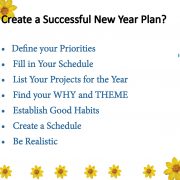Do you have a plan laid out for the new year? Do you know your priorities and goals?
Even though it may change throughout the year, It’s important to give yourself a starting point to at least start the year on the right foot.
What is your focus for the new year? Take time to list out your priorities with pen and paper and rank them in order of importance. I like to go through and pick my top 3-5 priorities for this season. Remember, our seasons can change throughout the year. So we’re just establishing what’s most important to us right now.
Look at a yearly calendar. What essential commitments have you already made? What important holidays, birthdays, and events do you need to plan around?
Once you have the major events penned in, you will have a better idea of what kinds of projects and goals for the year will be realistic.
This is where having planner you love really comes in handy. When you find a planner that works well for your life, using it is easier and you end up being more prepared and organized.
- List Your Projects for the Year
This step is all about figuring out the “big” things you want to accomplish and then breaking those goals down into smaller steps. First, write down all your dreams for the year. Then, pick what is actually realistic.
First of all, what’s the “Why” behind your goals? Why do you want to accomplish those goals you set? How are they going to impact your life? How will you feel when it’s done?
Next, it’s fun to set a theme for the year.
I think that good habits are essential to achieving your goals.
For example, if your goal is to get up a half hour earlier every day, some habits that would support that goal might be prepping your clothes and breakfast the night before or making sure you go to bed on time.
I think this is important to mention when creating a plan because managing your time and schedule well will be key to actually achieving your goals.
So create a schedule and block out times where you will work on your goals.
If your goals are too audacious, you may get frustrated with lack of progress and ignore them. On the other hand, if they’re too small, you’re more likely to procrastinate because you’ll have “Plenty of time to get them done.”
I think somewhere in the middle is the perfect place to be with your goals – just a bit more than you think you can do. Also remember that you can change your goals! They’re not set in stone. In six months you may be in a completely different place, and that’s ok!
A mid-year check on your goals, or even better, quarterly, is a good idea to make sure you’re on track and to see if there’s anything you need to change.
by Laura sue shaw





